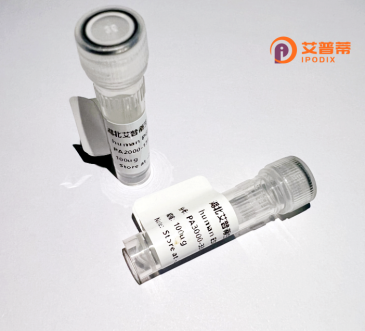
| 纯度 | >90%SDS-PAGE. |
| 种属 | Human |
| 靶点 | VIPR2 |
| Uniprot No | P41587 |
| 内毒素 | < 0.01EU/μg |
| 表达宿主 | E.coli |
| 表达区间 | 1-438aa |
| 活性数据 | MRTLLPPALLTCWLLAPVNSIHPECRFHLEIQEEETKCAELLRSQTEKHKACSGVWDNITCWRPANVGETVTVPCPKVFSNFYSKAGNISKNCTSDGWSETFPDFVDACGYSDPEDESKITFYILVKAIYTLGYSVSLMSLATGSIILCLFRKLHCTRNYIHLNLFLSFILRAISVLVKDDVLYSSSGTLHCPDQPSSWVGCKLSLVFLQYCIMANFFWLLVEGLYLHTLLVAMLPPRRCFLAYLLIGWGLPTVCIGAWTAARLYLEDTGCWDTNDHSVPWWVIRIPILISIIVNFVLFISIIRILLQKLTSPDVGGNDQSQYKRLAKSTLLLIPLFGVHYMVFAVFPISISSKYQILFELCLGSFQGLVVAVLYCFLNSEVQCELKRKWRSRCPTPSASRDYRVCGSSFSRNGSEGALQFHRGSRAQSFLQTETSVI |
| 分子量 | 73.92 kDa |
| 蛋白标签 | GST-tag at N-terminal |
| 缓冲液 | PBS, pH7.4, containing 0.01% SKL, 1mM DTT, 5% Trehalose and Proclin300. |
| 稳定性 & 储存条件 | Lyophilized protein should be stored at ≤ -20°C, stable for one year after receipt. Reconstituted protein solution can be stored at 2-8°C for 2-7 days. Aliquots of reconstituted samples are stable at ≤ -20°C for 3 months. |
| 复溶 | Always centrifuge tubes before opening.Do not mix by vortex or pipetting. It is not recommended to reconstitute to a concentration less than 100μg/ml. Dissolve the lyophilized protein in distilled water. Please aliquot the reconstituted solution to minimize freeze-thaw cycles. |
以下是关于重组人VIPR2(VPAC2)蛋白的3篇示例参考文献,供参考:
---
1. **文献名称**:*Structural insights into ligand binding and activation of the human VPAC2 receptor*
**作者**:Li et al., 2022
**摘要**:通过冷冻电镜解析重组人VIPR2蛋白与其天然配体血管活性肠肽(VIP)的结合结构,揭示了配体识别和受体激活的分子机制,为靶向该受体的药物开发提供依据。
---
2. **文献名称**:*Recombinant expression and functional characterization of VPAC2 in metabolic regulation*
**作者**:Wang et al., 2020
**摘要**:在哺乳动物细胞中重组表达VIPR2蛋白,研究其在胰岛β细胞中的功能,发现VIPR2激活可通过cAMP信号通路促进胰岛素分泌,提示其在糖尿病治疗中的潜力。
---
3. **文献名称**:*Development of a VPAC2-specific monoclonal antibody using recombinant protein immunization*
**作者**:Garcia-Rodriguez et al., 2018
**摘要**:利用重组人VIPR2蛋白免疫小鼠,成功制备高特异性单克隆抗体,应用于免疫组化和流式细胞术,为VIPR2相关疾病诊断提供工具。
---
**备注**:以上为基于研究领域的示例文献,实际文献需通过PubMed、Google Scholar等数据库检索确认。建议使用关键词“recombinant human VPAC2”“VIPR2 protein structure”“VPAC2 signaling”等进一步查找。
**Vasoactive Intestinal Peptide Receptor 2 (VIPR2)**, also known as VPAC2. is a class B G protein-coupled receptor (GPCR) that binds vasoactive intestinal peptide (VIP) and pituitary adenylate cyclase-activating polypeptide (PACAP). It is widely expressed in the central nervous system, immune cells, pancreas, gastrointestinal tract, and cardiovascular tissues. VIPR2 plays critical roles in modulating circadian rhythms, neurotransmission, immune responses, and metabolic regulation by activating downstream signaling pathways (e.g., cAMP/PKA, MAPK, and calcium mobilization).
Dysregulation of VIPR2 is implicated in neurological disorders (e.g., schizophrenia, autism), inflammatory diseases, diabetes, and circadian rhythm disruptions. Its involvement in tumor growth and angiogenesis has also drawn attention in cancer research.
**Recombinant human VIPR2 protein** is typically produced using mammalian expression systems (e.g., HEK293 or CHO cells) to ensure proper post-translational modifications and ligand-binding activity. This engineered protein retains the extracellular ligand-binding domain or full-length structure, enabling studies on receptor-ligand interactions, signaling mechanisms, and drug screening. Researchers utilize it to explore VIPR2's physiological roles and develop therapeutics targeting VIPR2-related pathologies. Its applications span structural biology, molecular pharmacology, and translational medicine.
×